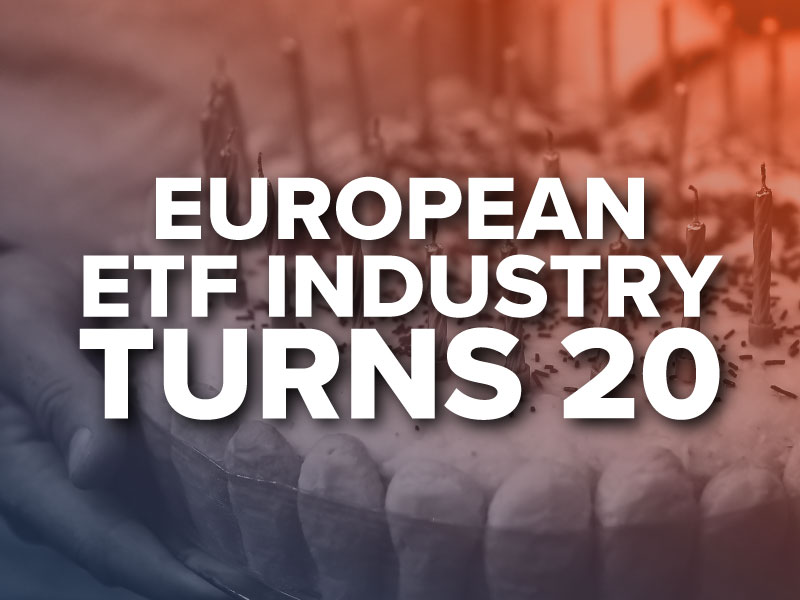ETFs in Europe are set to turn 20 years old on 11 April in another major milestone for the product which has taken the investment landscape by storm over the past two decades.
The first ETFs were launched by Merrill Lynch on the Deutsche Börse on 11 April 2000, the Dow Jones Euro STOXX 50 and Dow Jones Euro STOXX 50 LDRS ETFs.
The iShares FTSE 100 ETF was subsequently listed on the London Stock Exchange on 28 April, then under the Barclays Global Investors brand.
The rapid growth of ETFs over the past decade has been remarkable. Assets in European-listed ETFs crashed through the $1trn barrier at the start of the year, up from $143bn in 2008, however, this number has since fallen back amid the ongoing market turbulence.
As European ETFs turn 20 years old, ETF Stream asked five heads of ETF issuers what the biggest changes they have seen over the past two decades and where they see the European ETF industry heading.
David Lake, UK CEO of Lyxor
The growth of the European ETF industry over the last twenty years has been nothing short of phenomenal, and must be considered to be one of the great success stories in modern finance.
Through their ability to offer highly cost-effective exposure to markets across the world, ETFs have become truly mainstream and now form a core part of many investors’ portfolios.
Interestingly, however, we have seen the way in which investors use ETFs evolve over time – no longer are these used simply to gain access to markets at low cost, they are now increasingly being used as a means of reflecting investors’ own preferences towards major issues such as the environment, technology, energy provision and social change.
Having played a leading role in the development of the European ETF industry over the last twenty years, this is a trend that we expect to continue and grow.
Stephen Cohen, head of EMEA iShares and index investments at BlackRock
We will continue to see ETFs revolutionising more sectors and breaking new boundaries over the next two decades. Asset management is going through a structural shift driven by regulation and technology.
A new focus on the true sources of returns will shift the industry from traditional security selection toward a whole-portfolio, outcome-oriented approach where indexing and ETFs take centre-stage.
Developments in fixed income, factors and the seismic shift to sustainable investing will drive the next leg of ETF and index fund growth in the region.
Howie Li, head of ETFs at Legal & General Investment Management
What is remarkable about the past 10 years especially is the much wider adoption of ETFs.
They used to be seen as tactical tools only for short term investing. Now, they are widely being used as strategic building blocks for the long term.
Across Europe, we will continue to see more institutional usage over time and it is encouraging to see that central banks are using ETFs to express their monetary policy; this is a recognition that ETFs are simple and dependable to use and are diverse investment tools.
As for investment strategies, this is probably where the change is most obvious now.
While some still think about basic market cap index trackers as applying to all ETFs, many are now aware that the strategies available and that could fit in the ETF wrapper is much more diverse.
Investors are recognising that ETFs are similar to other UCITS wrappers as they become aware that portfolios can be weighted alternatively and focus on factors, themes, sustainable objectives or even active discretionary strategies.
MJ Lytle, CEO of Tabula Investment Management
Although European ETFs turn 20 years old this year, they leverage much older technology. For example, the Dow Jones Industrial Average was first published on 26 May 1896 and UCITS was adopted in 1985.
The major differences between now and 2000 is the total expense ratios (TERs) investors pay for ETFs and the democratisation of investing. Small institutions have access to the same product as the industry behemoths and the end investor has been empowered with a broad fund toolkit.
Over the next two decades, I expect trading access to all funds to continue to improve while fixed income ETFs will be the major engine of growth.
Mark Fitzgerald, head of product specialists, Europe, at Vanguard
To my mind the real story has been less the industry’s growth, but how well broadly-diversified, low-cost ETFs have served European investors over the past twenty years, through bull and bear markets alike.
It is worth remembering that ETFs were born out of the SEC’s interest in creating more liquid investing tools following the 1987 market crash. They were launched in Europe in the teeth of the tech bubble, have been through the Global Financial Crisis of 2008, and are trading at unprecedented levels through the present market volatility.
Through all this, and under intense scrutiny, they have continued to reliably provide liquidity, transparency and diversification. Their growing adoption by retail investors is an outcome of their value as a product, and will continue to catalyse the sector’s growth going forwards.
Sign up to ETF Stream’s weekly email here







